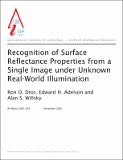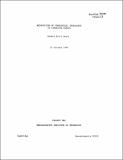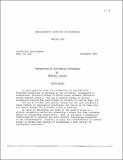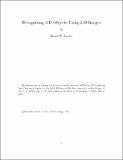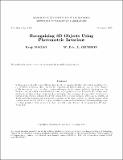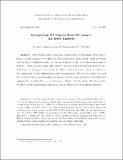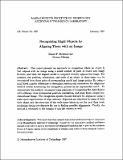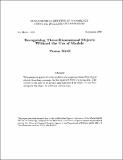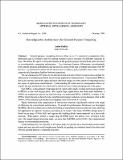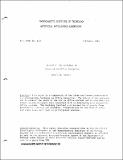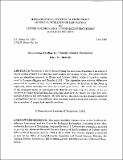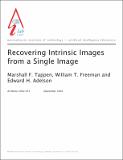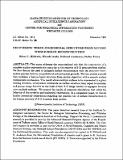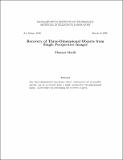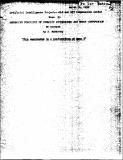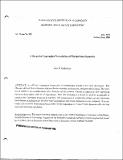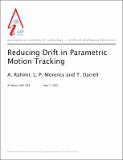Browsing Artificial Intelligence Lab Publications by Title
Now showing items 1327-1346 of 1835
-
The Recognition of Sharp, Closely Spaced Edges
(1974-12-01)The recognition of sharp edges from edge- and bar-mask convolutions with an image is studied for the special case where the separation of the edges is of the order of the masks' panel-widths. Desmearing techniques are ... -
Recognition of Surface Reflectance Properties from a Single Image under Unknown Real-World Illumination
(2001-10-21)This paper describes a machine vision system that classifies reflectance properties of surfaces such as metal, plastic, or paper, under unknown real-world illumination. We demonstrate performance of our algorithm for ... -
Recognition of Topological Invariants by Iterative Arrays
(1969-10-01)A study is made of the recognition and transformation of figures by iterative arrays of finite state automata. A figure is a finite rectangular two-dimensional array of symbols. The iterative arrays considered are ... -
Recognition of Topological Invariants by Modular Arrays
(1968-09-01)In this paper we study recognition of topological invariant properties of patterns by use of finite, rectangular 2-dimensional, interactive arrays of finite state automata (hereafter called modular arrays). The use of ... -
Recognizing 3-D Objects Using 2-D Images
(1993-04-01)We discuss a strategy for visual recognition by forming groups of salient image features, and then using these groups to index into a data base to find all of the matching groups of model features. We discuss the most ... -
Recognizing 3D Object Using Photometric Invariant
(1995-04-22)In this paper we describe a new efficient algorithm for recognizing 3D objects by combining photometric and geometric invariants. Some photometric properties are derived, that are invariant to the changes of illumination ... -
Recognizing 3D Ojbects of 2D Images: An Error Analysis
(1992-07-01)Many object recognition systems use a small number of pairings of data and model features to compute the 3D transformation from a model coordinate frame into the sensor coordinate system. With perfect image data, these ... -
Recognizing Indoor Scenes
(2001-07-25)We propose a scheme for indoor place identification based on the recognition of global scene views. Scene views are encoded using a holistic representation that provides low-resolution spatial and spectral information. The ... -
Recognizing Rigid Objects by Aligning Them with an Image
(1987-01-01)This paper presents an approach to recognition where an object is first {\\it aligned} with an image using a small number of pairs of model and image features, and then the aligned model is compared directly against ... -
Recognizing Three-Dimensional Objects without the Use of Models
(1989-09-01)We present an approach to the problem of recognizing three-dimensional objects from line-drawings. In this approach there are no models. The system needs only to be given a single picture of an object; it can then ... -
Reconfigurable Architectures for General-Purpose Computing
(1996-09-01)General-purpose computing devices allow us to (1) customize computation after fabrication and (2) conserve area by reusing expensive active circuitry for different functions in time. We define RP-space, a restricted ... -
Record of the Workshop on Research in Office Semantics
(1981-02-01)This paper is a compendium of the ideas and issues presented at the Chatham Bars Workshop on Office Semantics. The intent of the workshop was to examine the state of the art in office systems and to elucidate the ... -
Recovering Heading for Visually-Guided Navigation
(1991-06-01)We present a model for recovering the direction of heading of an observer who is moving relative to a scene that may contain self-moving objects. The model builds upon an algorithm proposed by Rieger and Lawton (1985), ... -
Recovering Intrinsic Images from a Single Image
(2002-09-01)We present an algorithm that uses multiple cues to recover shading and reflectance intrinsic images from a single image. Using both color information and a classifier trained to recognize gray-scale patterns, each image ... -
Recovering Three-Dimensional Structure from Motion with Surface Reconstruction
(1991-12-01)We address the computational role that the construction of a complete surface representation may play in the recovery of 3--D structure from motion. We present a model that combines a feature--based structure--from- ... -
Recovery of Three-Dimensional Objects from Single Perspective Images
(1998-03-01)Any three-dimensional wire-frame object constructed out of parallelograms can be recovered from a single perspective two-dimensional image. A procedure for performing the recovery is given. -
Recursive Functions of Symbolic Expressions and Their Computation
(1959-03-30)This memorandum is a continuation of Memo 8. -
Recursive Functions of Symbolic Expressions and Their Computation by Machine
(1959-03-13)The attached paper is a description of the LISP system starting with the machine-independent system of recursive functions of symbolic expressions. This seems to be a better point of view for looking at the system than the ... -
A Recursive Lagrangian Formulation of Manipulator Dynamics
(1980-06-01)An efficient Lagrangian formulation of manipulator dynamics has been developed. The efficiency derives from recurrence relations for the velocities, accelerations, and generalized forces. The number of additions and ... -
Reducing Drift in Parametric Motion Tracking
(2001-05-07)We develop a class of differential motion trackers that automatically stabilize when in finite domains. Most differ-ential trackers compute motion only relative to one previous frame, accumulating errors indefinitely. We ...


